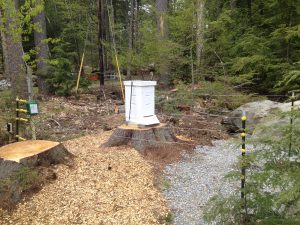How to Install Electric Fence for Protecting Beehives from Bears
By Mark J. Donovan
|
|
In preparation for the arrival of my nucleus colony of bees I installed an electric fence around my Langstroth beehive box to protect it and its future family of bees from prowling bears.
Bears are plentiful in the lakes region of New Hampshire, and from the advice of my beekeeper instructor I decided to install an electric bear fence before the bees arrived. |
The task turned out to be more complicated than I originally planned. Mainly because I couldn’t find all the parts at one store, but also because of the fact that I was in learning mode along the way. In the ensuing paragraphs I share with you what I learned about installing electric fences for bees and how and what I actually installed for an electric bear fence.
Electric Fence Sizing
In regards to the size of my electric bear fence, I made it roughly twelve feet by twelve feet, with the beehive box centered in the middle of it. This size ensured that the beehive would be at least five feet away from all sides of the electric fence, well outside the distance of a bear’s reach. I used four 5-1/2 foot long metal T-posts to set the perimeter of the fence and attached insulators that easily clipped onto the T-posts.
Electric Fence Chargers
I then researched electric fence chargers. There are basically three types to choose from: AC powered, DC (battery) powered, and solar powered. Due to the fact that my beehive is not located near AC power, and the fact that I didn’t want to spend an excessive amount of money on a solar powered electric fence charger, I decided on a DC electric fence charger. The charger is powered by a 12 volt deep cycle marine battery. From what I have been told the battery should last a good month on a single charge, assuming the electric bear fence isn’t shorting out to ground via grass, weeds and branches touching it.
Also in regards to electric fence chargers, I learned for bears that the electric fence charger should be able to output at least 0.7 Joules of energy. I chose one that outputted 1 joule. From what I learned, anything less than 0.7 joules of energy would provide such a minimal electrical shock to the bear that it would likely not be enough to frighten off the bear.
In regards to the battery I chose a 12 volt deep cycle marine battery that provides 40AH. The charger simply connects to the two leads on the battery.
Grounding Rods
Another key component associated with installing an electric bear fence are grounding rods. I pounded two 3 foot long grounding rods into the ground, within a few feet of the charger, and tied them together with 20KV insulated wire using ground rod clamps. I then attached one end of the grounding rods to the ground side of the electric fence charger.
|
|
Electric Fence WireFor the actual electric fence wire I used heavy duty 14 gauge aluminum wire. You need this type of wire to ensure bears can’t simply break the wire by pushing up against it. I installed four loops of the electric wire up the T-posts, the first about 12 inches off the ground and then the next three loops at roughly 30, 40 and 50 inches, respectively. I made sure that I carefully wrapped the aluminum electric fence wire around each insulator and that the wire did not touch the electric fence posts. |
I also installed four electric fence handles, one for each perimeter wire loop. One end of each handle attaches directly to one side of the wire loop, and the other end attaches to a small ½ inch loop on the opposite end of the wire to close the circuit.
After installing the four electric fence wire loops I tied them all together with one vertical running piece of 14 gauge wire. I then immediately followed by attaching one end of a length of insulated 20KV rated wire to the electric fence wire and the other end to the high side of a large cut-out switch.
Lastly, I attached another length of insulated 20KV rated wire to the low side of the large cut-out switched, and the other end to the positive terminal on the electric fence charger.
Note that I mounted the cut-out switch on a wooden pressure treated post that was pounded into the ground just outside the fence. Also, I mounted the electric fence charger on a similar post, but that post was located within the confines of the electric fence. Lastly, I placed the battery in a water-tight container that sits on the ground, next to the electric fence charger.
|
|
Note that I mounted the cut-out switch on a wooden pressure treated post that was pounded into the ground just outside the fence. Also, I mounted the electric fence charger on a similar post, but that post was located within the confines of the electric fence.
Lastly, I placed the battery in a water-tight container that sits on the ground, next to the electric fence charger. |
After finally completing the electric bear fence installation I tested out the fence with a specifically designed electric fence tester.
After energizing the charger I was able to confirm via the tester that the charger was outputting a 7KV+ pulse onto the electric fence. It is important to note that electric fence chargers output a pulsed voltage at a 1 second duty cycle rate. This way an animal doesn’t get “stuck” on the electric fence. Once the pulse is shot out by the charger, the charger briefly turns off and any animal that is touching the electric fence wire can pull away from it.
So when my bees arrive in the next few days, thanks to my newly installed electric bear fence, I’ll be able to sufficiently protect them from curious bears.
Dress Up Your Home’s Exterior with an Arbor – If you’ve always wondered what to do about a side door entrance to your house or garage to make it more appealing, or just wanted to simply spice up the backyard, building an arbor may be your answer. The “How to Build an Arbor Ebook” provides detailed, step-by-step instructions and pictures on how to build an entrance-way arbor for your home. Order and Immediately Download today!. 100% Money-Back Guarantee if you are not satisfied.
Planning to have a Brick or Paver Walkway Installed by a Landscaping Contractor but not sure what questions to ask to ensure you hire the right one? See HomeAdditionPlus.com’s Brick and Paver Walkway Bid Sheet. The Brick and Paver Walkway Bid Sheet will help ensure that your walkway project goes smoothly and you get the finished walkway you are looking for.
Related Information
- Winterizing a Beehive Video
- How to Install a Stone Paver Walkway Video
- Paver Stone Walkway Accent Pieces Video
Additional Beekeeping Resources from Amazon.com
 |
 |
Free Home Addition Price Quotes with No Obligation!
Fill out our 3-5 minute quick and easy form, and receive a free price quote on a house addition from one of our prescreened and licensed home addition contractors. This process is free and there is no obligation to continue once you receive your house addition price estimate.



